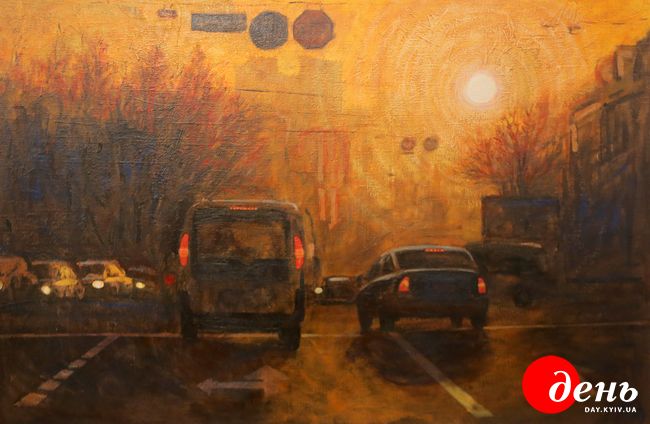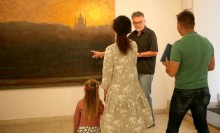The exhibit is named “Private City.” While art critics keep locking horns over what the “Kyiv art school” is, artists are painting Kyiv, their most favorite city. Viktor Khomenko’s “Private City” creates a strong impression. His Kyiv is, to a large extent, expressionism (and, obviously, the cycle has no formal signs of “nude art” or “erotica”). Those who viewed the pictures for the first time saw Kyiv as a “corporeal,” 3D, and living city. It is a genuine Kyiv, the one we love and know down to the minutest detail.
Viktor KHOMENKO is well known in the art milieu. It will be recalled that as far back as 1976 he was a co-organizer of the first unofficial exhibit of nonconformist artists in our capital. He began exhibit officially in the late 1980s. It is he who published for many years on sheer enthusiasm (and continues to do so today, if possible) the influential journal Obrazotvorche Mystetstvo (“Fine Arts”). Unfortunately, Khomenko’s popularity among the broad masses of contemporary art appreciators is almost inversely proportional to his fame among his colleagues. This master of Ukrainian avant-garde is clearly underestimated – in contrast, by the way, to his famous daughters, artist Lesia and designer Yasia (although it is impossible not to notice the impact of father’s work on the Khomenkos’ younger generation).
“Private City” is Viktor Khomenko’s new painting cycle, unexpected from many angles to the connoisseurs of his usually ironic oeuvre.

“I’ve been searching for the ‘new’ in art for all my lifetime,” the artist says. “And now, unexpectedly even for myself, I’d like to ‘cast an anchor.’ I need graphicness. Landscape is the most demanded genre of Ukrainian painting. But the commercial side of the matter did not interest me. The point is I do not often leave the city and spend most of the time at the wheel of my car. Whenever I drive, I watch urban landscapes. Yet the ‘Private City’ cycle is not about the city or landscapes. It is a story of me – a personal one, like a diary.”
The city, a model of the Universe, a heavenly Kyiv, livened up under Khomenko’s paintbrush and emerges in a combination of “sunny” hues. No wonder, the word “sunset” runs through the names of some of the cycle’s pictures – “Sunset Street” – “Vulytsia Symona Petliury,” “Sunset Minibus,” “Sunset Avenue” – “Brest-Lytovskyi Prospekt). And this incredible picture in a mixture of hot-yellow-orange, blue and black colors, is titled “Sunlight” and, in Ukrainian, “Svitlo Sontsia Bohdana Khmelnytskoho.” In most of the pictures, the hot-yellow background and sunrays contrast with gray and black manmade objects. It is the easily recognizable bridges and overpasses (e.g., “The Bridge” – “Moskovskyi Mist”). A string of cars, gray winter snow (“Winter Time” – “Zymovyi Chas”), the pedestrian bridge, and Dnieper hills under the bleak winter sky (“Privale City” – “Pryvatne Misto”).

Step by step, a grandiose picture unfolds before your eyes: Kyiv as a battlefield of true “Gnostic” cosmogony, where the forces of the Sun rival with the darkness of evil. Or, maybe, the eternal sleep of Brahma? Quite to the point, one of the largest canvases of the cycle, “The Hill over the River” – “Naberezhno-Khreshchatytska St.,” seems to show some inscriptions in Sanskrit. Incidentally, the “dual” names of each picture can also testify to the “binarity” of Kyiv, the city of Andrew the Apostle and of the Black Serpent.
“In painting, everybody tends to see his own,” Khomenko notes. “And what pleases me is that, perhaps for the first time in my lifetime, none of the exhibit visitors asked me: ‘What do your pictures mean?’ There is no invisible wall that usually rises between the spectator and the artist with his works! It is an incredible feeling, when pictures are self-sufficient.”
The exhibit “Private City” will remain open till April 25.







